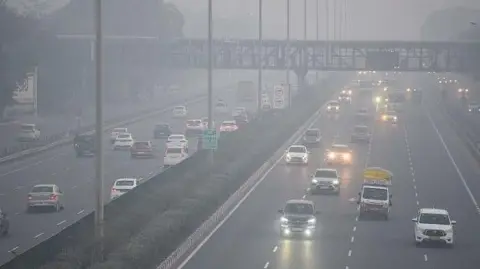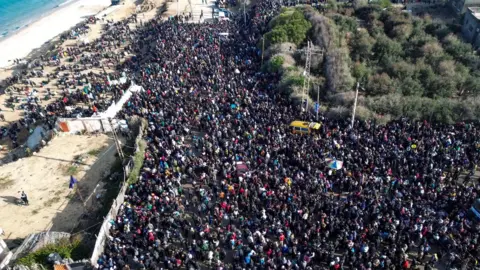
Delhi smog causes travel chaos
Smog Paralyzes Delhi: Travel Disruptions in the Indian Capital
Marianswoman – Delhi, the bustling capital of India, is no stranger to severe air pollution, but recent reports show that smog levels have reached catastrophic proportions, causing widespread travel chaos. With the city’s air quality plummeting into hazardous zones, both locals and visitors are grappling with disrupted flights, delayed trains, and a massive impact on daily commutes. This smog episode highlights a growing environmental crisis and the toll it takes on one of the world’s most populous cities.
The Causes Behind Delhi’s Smog Crisis
Delhi’s air pollution crisis is driven by several factors, with smog intensifying in the colder months due to a combination of crop burning, industrial emissions, and vehicle exhaust. During the winter season, the stagnant air traps pollutants close to the ground, worsening smog levels. The situation has become particularly dire in the last few years, as the city has seen a surge in both industrial growth and vehicular traffic, further fueling the smog epidemic.
The Indian capital’s geographic location, with surrounding agricultural areas, makes it prone to the seasonal burning of crop stubble. This practice, though illegal, continues due to insufficient enforcement and alternative farming solutions. When combined with the high levels of vehicular pollution, the smog in Delhi can reduce visibility to just a few meters, making travel treacherous.
Smog’s Impact on Air Travel in Delhi
The most immediate effect of Delhi’s smog crisis has been on air travel. At Indira Gandhi International Airport, one of the busiest airports in the country, visibility has been reduced to dangerously low levels. This has led to numerous flight delays and cancellations, especially for those arriving or departing during the morning and evening hours.
Flight disruptions have caused immense frustration for travelers, many of whom have had to endure long delays or rebooked flights. The airlines, although operational, have been facing significant logistical challenges in managing the sheer volume of passengers stranded at the airport. For those traveling internationally or domestically, the smog has turned what should be a routine travel experience into a stressful ordeal.
Train Services Hit Hard by Smog in Delhi
In addition to air travel, Delhi’s iconic railway network has also been heavily impacted by the thick smog. Trains are frequently delayed or diverted as low visibility makes it difficult for train operators to navigate tracks safely. This has affected thousands of daily commuters, many of whom rely on trains for their work commutes or long-distance travel.
In the worst-hit regions, trains have been stuck for hours, with passengers left stranded in overcrowded stations. As the city struggles with an overwhelmed transport system, the economic consequences of smog-related disruptions are becoming increasingly apparent.
Health Risks and Public Safety Concerns
Beyond the travel chaos, the smog has raised serious health concerns for Delhi’s residents. The thick blanket of pollution is laden with harmful particles that pose significant risks to respiratory health. The elderly, children, and individuals with pre-existing conditions like asthma are particularly vulnerable to the adverse effects of Delhi’s air quality.
Hospitals have reported a surge in cases of respiratory distress, and air quality indices have been at hazardous levels for days. The government has issued public health advisories urging people to stay indoors and wear protective masks when venturing outside. Despite these warnings, many people are forced to go about their daily lives, including traveling to work or school, despite the risks.
What Is Being Done to Combat Delhi’s Smog?
The city has attempted various measures over the years to mitigate the impact of air pollution. The odd-even car rationing scheme, which restricts the use of private vehicles based on license plate numbers, has seen temporary success in reducing vehicle emissions. Additionally, there has been a push to promote cleaner energy sources and better waste management practices. However, these solutions have proven to be insufficient in addressing the city’s long-term pollution issues.
Furthermore, Delhi’s government has been exploring alternative agricultural practices to reduce crop burning, but these initiatives require significant investment and time to implement. As long as these measures remain short-term, the city is likely to continue facing the seasonal smog crises that have plagued it for years.
International Attention on Delhi’s Smog Problem
Delhi’s smog problem has garnered international attention, with global health organizations and environmental activists calling for more urgent action. Studies have shown that Delhi’s air quality is among the worst in the world, with smog contributing to thousands of premature deaths annually. The city’s environmental crisis has become a point of concern for neighboring countries as well, as the effects of air pollution do not recognize borders.
As the global community pushes for more climate action and better urban planning, Delhi’s pollution challenges remain a stark reminder of the environmental cost of rapid industrialization and urban growth.
Looking Ahead: Can Delhi Overcome Its Smog Problem?
The current situation in Delhi is a warning sign that the city’s air pollution crisis cannot be ignored any longer. While temporary solutions may provide some relief, long-term strategies are essential to addressing the root causes of the problem. Effective enforcement of laws, a shift to green technologies, and a change in public attitudes toward pollution are critical to combating the smog that regularly paralyzes the city.
As the Indian government and local authorities work toward solutions, the public’s involvement in reducing pollution—by supporting cleaner practices and being more environmentally conscious—will be equally important in tackling Delhi’s air quality crisis.



